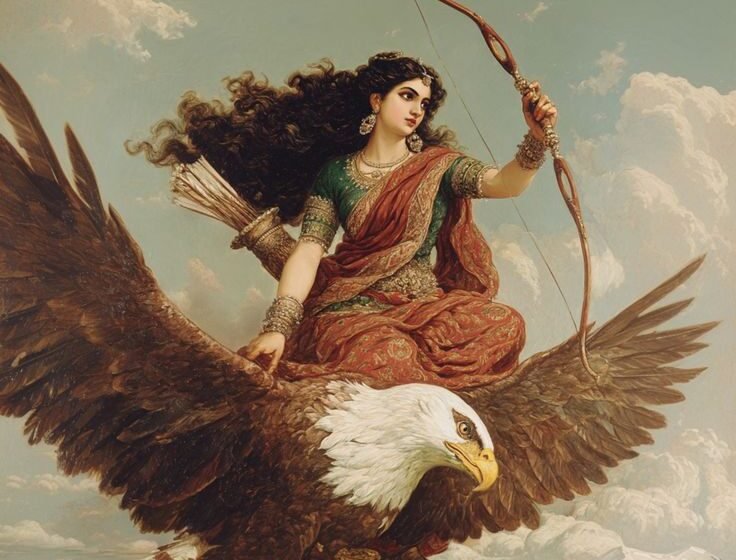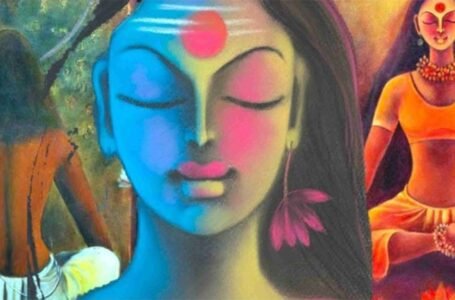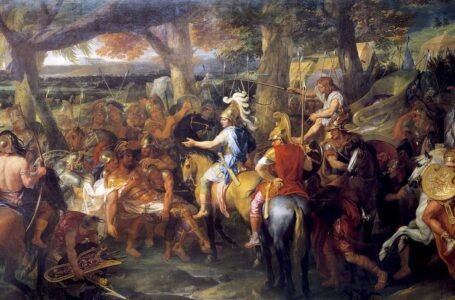Satyabhama: The Warrior Queen and Consort of Lord Krishna

-Anushka Sengupta
Satyabhama, one of the most interesting characters in Hindu Mythology and a favorite of mine, was one of the Ashtabharya of Lord Krishna. Depicted as an intricate amalgamation of aesthetics, dignity, courage, and faith, Satyabhama holds a special place in the Krishna-centric stories of the Mahabharata, Bhagavata Purana, and numerous local legends. Referred to variously as the warrior princess, the fiery consort, and avatar of the Earth goddess (Bhudevi), Satyabhama is far from the docile or submissive mythological queen. She is strength and integrity and feminine pride, carving her way through the timeless divine narratives of Krishna – not as a consort, but as a force to be reckoned with in her own right.
Mythological Background and Birth
Satyabhama was the princess of King Satrajit, who was a Yadava nobleman and a devout worshipper of Surya (the Sun God). As per Bhagavata Purana and Vishnu Purana, the jewel Syamantaka was given to Satrajit by the Sun God as a symbol of his devotion. This jewel possessed the capability to yield eight bhāras of gold every single day and was thought to confer wealth upon its holder. It is here that the story of Satyabhama becomes connected to this gem – it is at the center of Krishna’s confrontation with Satrajit, and ultimately, Satyabhama’s marriage with Krishna.
First, when Krishna asked Satrajit to give up the Syamantaka jewel to Ugrasena for the welfare of the Yadavas, he refused. When Satrajit’s brother Prasena died wearing the gem, Krishna came under suspicion. To clear his name, Krishna undertook a quest that led him to the bear king Jambavan, who had taken the gem. In a battle with Jambavan, Krishna defeated him, not only restoring the Syamantaka but marrying Jambavati, Jambavan’s daughter. When Satrajit found out, he apologized and gave both the jewel and his daughter Satyabhama to Krishna in marriage.
Satyabhama’s Personality: Pride, Devotion, and Strength
Among all of Krishna’s wives, Satyabhama is characterized by her assertive and somewhat possessive love for Krishna. She is portrayed as strong-willed, jealous at times, and proud of her beauty and wealth. In many folk narratives and Puranic retellings, Satyabhama often quarrels with Krishna over his love for Rukmini, his first wife, whose submissive and quiet nature starkly contrasts with Satyabhama’s fire. However, this jealousy and pride are not shown negatively—instead, they highlight Satyabhama’s human qualities and add depth to her character.
Despite her pride, Satyabhama’s devotion to Krishna is unwavering. Her actions and emotions reflect the Sringara Rasa (the aesthetic of love and beauty) found in Bhakti traditions, where love for God is sometimes expressed through longing, quarrel, and intense possessiveness. Her interactions with Krishna often serve as metaphors for the soul’s passionate yearning for the divine.
The Tulabharam (Weighing Scale) Story
One of the most celebrated stories involving Satyabhama is the Tulabharam episode, often told in South Indian traditions and depicted in classical dance and temple murals. In this tale, Satyabhama, in her pride, boasts that she can outweigh Krishna in wealth. To prove her devotion and superiority over Rukmini, she arranges for Krishna to be weighed against her treasures. Despite all her gold and jewels, the scale refuses to tilt. Finally, Rukmini comes forward and offers a single tulsi leaf (holy basil) with pure devotion. Miraculously, the scale tips in favor of Rukmini.
This story is allegorical and carries profound spiritual lessons. It demonstrates the power of Bhakti (devotion) over Aishwarya (material wealth), suggesting that even the smallest offering made with true love is more valuable than the grandest of possessions. It also humbles Satyabhama and serves as a moment of personal transformation in her relationship with Krishna.
Role in the Narakasura Vadha (Slaying of the Demon Narakasura)
Satyabhama’s most heroic and defining moment comes in the story of the slaying of Narakasura, a demon king who terrorized the heavens and imprisoned thousands of celestial maidens. According to some versions, Narakasura was the son of Bhudevi and Varaha (an incarnation of Vishnu), and he could only be killed by his mother. Since Satyabhama is believed to be an incarnation of Bhudevi, she accompanies Krishna in the battle.
In a dramatic turn, Krishna pretends to be wounded in battle, prompting Satyabhama to take up arms and slay Narakasura herself. This act marks her not only as a consort of Krishna but as a warrior goddess, representing justice and divine retribution. The incident is celebrated in many traditions, particularly in South India, and is associated with Naraka Chaturdashi, a festival observed just before Diwali.
Symbolism and Divine Status
Satyabhama is perceived to be the incarnation of Bhudevi, the Earth goddess. Satyabhama is the fiery, fertile, warrior goddess. In iconography she is pictured next to Krishna with a bow or sword and regal ornaments, and sometimes riding into battle with him.
Her character embodies the Tamasic facet of bhakti, ardent and fierce, and occasionally shrouded in ego, but subterranean and protean. This balances the Sattvic devotion of Rukmini and the Rajasic devotion of others such as Jambavati
Satyabhama in Dance, Literature, and Temple Culture
Satyabhama is a prominent figure in the Indian classical dance styles Kuchipudi and Bharatanatyam. The Kuchipudi solo ballet “Bhama Kalapam”, created by Siddhendra Yogi in the 17th century, is completely devoted to Satyabhama. The dance-drama traces her feelings, pride, love, anger and eventual reconciliation with Krishna. The performance was not only artistic but theological, depicting her as an icon of spiritual wrestling and surrender.
Temples to Satyabhama and Krishna are located in Andhra Pradesh, Tamil Nadu and in parts of Karnataka. She is frequently worshiped with Krishna on days like Satyabhama Jayanti, and features prominently in temple plays and ceremonies celebrating Naraka Chaturdashi.
Conclusion
Satyabhama is much more than a mythical queen or the consort of a divine hero; she is a dynamic character who encompasses power, beauty, pride, and ultimately spiritual evolution. From her royal heritage and marriage to Krishna, to her role in vanquishing Narakasura, to the telling of humility through Tulabharam, Satyabhama illustrates the complex life of the human spirit, from its root in ego, to a place of enlightenment, from pride to devotion. Her story continues to invoke inspiration through literature, temple worship, dance, and oral storytelling as she describes empowered femininity, spiritual bravery, and sincere love for God. Satyabhama’s legends and itihasa stories enrich Krishna’s mythology, and provide relevant lessons in life around balance, change, and paths to divine union.


